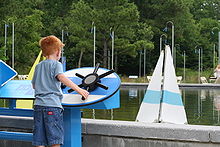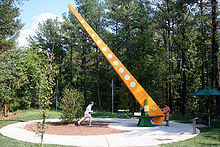- Museum of Life and Science
-
Coordinates: 36°01′43″N 78°53′50″W / 36.02865°N 78.89734°W
North Carolina Museum of Life and Science 
Location Durham, North Carolina Type science museum, children's museum, and zoo Website http://www.ncmls.org/ Association of Science-Technology Centers astc.org The Museum of Life and Science (formerly known as the North Carolina Museum of Life and Science and originally titled the NC Children's Museum) is a science museum located in Durham, North Carolina, USA, featuring an array of largely hands-on exhibits intended to illustrate concepts of natural science.
The museum exists on some 80 acres (320,000 m2) bisected by Murray Avenue. The main building is located on the north tract, along with the Butterfly House, Farmyard, Grayson's Cafe, Train, Explore the Wild nature park, Catch the Wind, and Dinosaur Trail. The museum features both indoor and outdoor learning environments. The southern tract is now largely devoted to parking and administrative buildings, although prior to the construction of the new main building in the early 1990s, these structures contained the bulk of the museum's exhibit space.
The Museum has come under criticism from visitors for not mentioning evolution in its exhibits,[1] despite having the word "Life" in its title and several significant exhibits that would merit such mention.
Contents
Exhibits
Aerospace
The MLS has historically been most notable for its Aerospace exhibit, which focuses on the early NASA space program. Most of the artifacts on display are on long-term loan from the National Air and Space Museum. Many of these are significant Project Apollo-related artifacts, such as a moon rock, Neil Armstrong's dosimeter, an Apollo Command Module test vehicle, a portion of a lunar rover, and a full-sized mock-up of a Lunar Module. The MLS came into possession of these artifacts through the influence of James E. Webb, the second NASA administrator and a native of North Carolina.
BioQuest
In the mid-1990s, the museum announced a 4 phase expansion to their outdoor exhibits they called BioQuest.[2]
Magic Wings Butterfly House
A major attraction at MLS is the three-story glass Magic Wings Butterfly House, which opened in 1999, a butterfly zoo and tropical conservatory featuring a community of several hundred tropical butterflies representing dozens of species, as well as an array of tropical plants. The Bayer CropScience Insectarium, located in the Magic Wings Butterfly House, features exotic insects from around the world.
Explore the Wild
Explore the Wild is home to American black bears, red wolves, and lemurs. It features a 900-foot (270 m) boardwalk over a preserved 6-acre (24,000 m2) natural space, plus many multimedia exhibits. The exhibit opened in May 2006.
Catch the Wind
Catch the Wind opened in the Summer of 2007 and features seven exhibits showing how the wind influences our environment.
A 30-foot (9 m) interactive tower elevates oversized representations of seed pods of trees native to North Carolina and drops them demonstrating how wind affects their travel. The ornithopter ride features 12 lifting wings and lifts visits for a view of the area. The centerpiece of the area is a 5,000-square-foot (500 m2) elliptical sailboat pond where visitors can sail remote controlled sailboats.[3][4]
Kiosks throughout the area allow visitors to listen to audio tracks of narratives, poems, and stories about the wind.
Dinosaur Trail
Long a local favorite, the Prehistoric Trail featured a number of life-size plaster amphibians, reptiles and dinosaurs set along a woodland path. Perhaps most notable was the Brontosaurus, still visible today from Murray Avenue. According to a 1965 pamphlet, the trail's original lineup featured a Seymouria, an Eryops, a Dimetrodon, an Araeoscelis, a Saltoposuchus, a Yaleosaurus, a Plateosaurus, and a Camptosaurus. Later additions included a T-Rex and a Triceratops. The trail also provided models of a mammoth and a rhinoceros for scale. The creatures were built by museum staff over a four-year period, culminating with the exhibit's completion in 1967. It was renamed the Dinosaur Trail in 1986. While most of the models still exist, the trail was rendered largely impassable by Hurricane Fran in 1996 and has since fallen into disrepair. Between 2006 and 2009, local residents worked with the museum to remove some of the debris from the trail.
The brontosaurus model was vandalized during the early morning hours of June 1, 2009, when vandals removed a large portion of the neck and the entire head. At a later date, the head was found, and the Brontosaurus was repaired and improved through a partnership with the local Northgate Park neighborhood.[5][6]
The final phase in the BioQuest expansion project, a new dinosaur trail (located in a different area on the museum's grounds) opened in July 2009. It features life size models of Albertosaurus, Styracosaurus, Troodon, Maiasaura, Stygimoloch, Alamosaurus, Leptoceratops, and Edmontonia. An interactive fossil dig area is also available where shovels and screens are available for children to search for, and take home, sharks teeth, coral, other fossils brought up from an abandoned mine in Eastern North Carolina which was once part of the ocean floor.[7]
Notes
- ^ Sad Example of a science museum Apr 13, 2008. Retrieved 2010-01-17.
- ^ "Museum Launches Threefold Expansion". 2004-05-01. http://www.durham-nc.com/media/evergreens-backgrounders/things/insectarium.php. Retrieved 2007-06-25.
- ^ "Museum of Life and Science to open 'Catch the Wind' - large-scale interactive outdoor science experience". http://carolinanewswire.com/news/News.cgi?database=1news.db&command=viewone&id=4948&op=t. Retrieved 2007-06-25.
- ^ "Visitors will discover new 'Wind' at museum". 2007-06-15. http://www.newsobserver.com/105/story/605052.html. Retrieved 2007-06-25.[dead link]
- ^ "newsobserver.com blogs tag brontosaurus". News and Observer. 2009-10-23. http://blogs.newsobserver.com/category/tags/brontosaurus. Retrieved 2009-10-23.
- ^ Old Bronotosaurus Damanged By Vandalism. . Museum of Life and Science. 2009-06-01. http://www.flickr.com/groups/dinos-in-durham/discuss/72157619108157470/. Retrieved 2009-06-02.
- ^ "Dinosaurs stalk the revamped trail at museum". News and Observer. Jul. 24, 2009. http://www.newsobserver.com/105/story/1617655.html. Retrieved 2009-09-12.[dead link]
External links
Zoos and aquaria of North Carolina Aquariums Zoos - Duke Lemur Center
- JB's Rattles Traveling Reptile Zoo
- Museum of Life and Science
- Natural Science Center of Greensboro
- North Carolina Zoo
- Triangle Metro Zoo
- Western North Carolina Nature Center
Zoos, aquariums, and aviaries Types of zoos Conservation Lists Animals Other topics - Animals in captivity
- Animal training
- Behavioral enrichment
- Captive breeding
- Frozen zoo
- Immersion exhibit
- Nocturnal house
- Wildlife conservation
- Zookeeper
- Zoology
- Portal
- Project
- Category
- Commons
Categories:- Museums in Durham, North Carolina
- Science museums in North Carolina
- Natural history museums in North Carolina
- Butterfly farms
- Insectariums
- Zoos in North Carolina
- Aerospace museums in North Carolina
Wikimedia Foundation. 2010.



